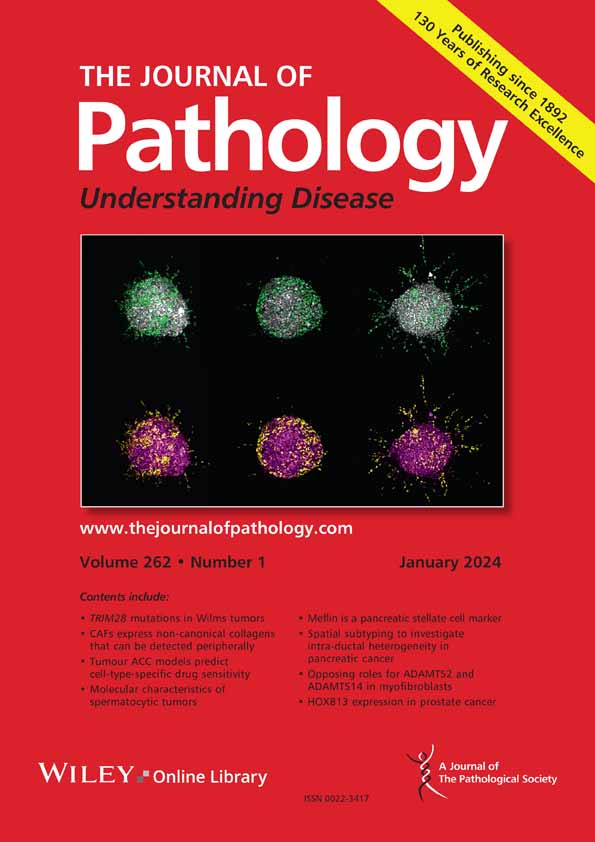Nicholas Trahearn, Chirine Sakr, Abhirup Banerjee, Seung Hyun Lee, Ann-Marie Baker, Hemant M Kocher, Valentina Angerilli, Federica Morano, Francesca Bergamo, Giulia Maddalena, Rossana Intini, Chiara Cremolini, Giulio Caravagna, Trevor Graham, Filippo Pietrantonio, Sara Lonardi, Matteo Fassan, Andrea Sottoriva
下载PDF
{"title":"计算病理学应用于临床结直肠癌队列确定预测结果的免疫和内皮细胞空间模式。","authors":"Nicholas Trahearn, Chirine Sakr, Abhirup Banerjee, Seung Hyun Lee, Ann-Marie Baker, Hemant M Kocher, Valentina Angerilli, Federica Morano, Francesca Bergamo, Giulia Maddalena, Rossana Intini, Chiara Cremolini, Giulio Caravagna, Trevor Graham, Filippo Pietrantonio, Sara Lonardi, Matteo Fassan, Andrea Sottoriva","doi":"10.1002/path.6378","DOIUrl":null,"url":null,"abstract":"<p>Colorectal cancer (CRC) is a histologically heterogeneous disease with variable clinical outcome. The role the tumour microenvironment (TME) plays in determining tumour progression is complex and not fully understood. To improve our understanding, it is critical that the TME is studied systematically within clinically annotated patient cohorts with long-term follow-up. Here we studied the TME in three clinical cohorts of metastatic CRC with diverse molecular subtype and treatment history. The MISSONI cohort included cases with microsatellite instability that received immunotherapy (<i>n</i> = 59, 24 months median follow-up). The BRAF cohort included BRAF V600E mutant microsatellite stable (MSS) cancers (<i>n</i> = 141, 24 months median follow-up). The VALENTINO cohort included RAS/RAF WT MSS cases who received chemotherapy and anti-EGFR therapy (<i>n</i> = 175, 32 months median follow-up). Using a Deep learning cell classifier, trained upon >38,000 pathologist annotations, to detect eight cell types within H&E-stained sections of CRC, we quantified the spatial tissue organisation and colocalisation of cell types across these cohorts. We found that the ratio of infiltrating endothelial cells to cancer cells, a possible marker of vascular invasion, was an independent predictor of progression-free survival (PFS) in the BRAF+MISSONI cohort (<i>p</i> = 0.033, HR = 1.44, CI = 1.029–2.01). In the VALENTINO cohort, this pattern was also an independent PFS predictor in <i>TP53</i> mutant patients (<i>p</i> = 0.009, HR = 0.59, CI = 0.40–0.88). Tumour-infiltrating lymphocytes were an independent predictor of PFS in BRAF+MISSONI (<i>p</i> = 0.016, HR = 0.36, CI = 0.153–0.83). Elevated tumour-infiltrating macrophages were predictive of improved PFS in the MISSONI cohort (<i>p</i> = 0.031). We validated our cell classification using highly multiplexed immunofluorescence for 17 markers applied to the same sections that were analysed by the classifier (<i>n</i> = 26 cases). These findings uncovered important microenvironmental factors that underpin treatment response across and within CRC molecular subtypes, while providing an atlas of the distribution of 180 million cells in 375 clinically annotated CRC patients. © 2025 The Author(s). <i>The Journal of Pathology</i> published by John Wiley & Sons Ltd on behalf of The Pathological Society of Great Britain and Ireland.</p>","PeriodicalId":232,"journal":{"name":"The Journal of Pathology","volume":"265 2","pages":"198-210"},"PeriodicalIF":5.6000,"publicationDate":"2025-01-09","publicationTypes":"Journal Article","fieldsOfStudy":null,"isOpenAccess":false,"openAccessPdf":"https://www.ncbi.nlm.nih.gov/pmc/articles/PMC11717494/pdf/","citationCount":"0","resultStr":"{\"title\":\"Computational pathology applied to clinical colorectal cancer cohorts identifies immune and endothelial cell spatial patterns predictive of outcome\",\"authors\":\"Nicholas Trahearn, Chirine Sakr, Abhirup Banerjee, Seung Hyun Lee, Ann-Marie Baker, Hemant M Kocher, Valentina Angerilli, Federica Morano, Francesca Bergamo, Giulia Maddalena, Rossana Intini, Chiara Cremolini, Giulio Caravagna, Trevor Graham, Filippo Pietrantonio, Sara Lonardi, Matteo Fassan, Andrea Sottoriva\",\"doi\":\"10.1002/path.6378\",\"DOIUrl\":null,\"url\":null,\"abstract\":\"<p>Colorectal cancer (CRC) is a histologically heterogeneous disease with variable clinical outcome. The role the tumour microenvironment (TME) plays in determining tumour progression is complex and not fully understood. To improve our understanding, it is critical that the TME is studied systematically within clinically annotated patient cohorts with long-term follow-up. Here we studied the TME in three clinical cohorts of metastatic CRC with diverse molecular subtype and treatment history. The MISSONI cohort included cases with microsatellite instability that received immunotherapy (<i>n</i> = 59, 24 months median follow-up). The BRAF cohort included BRAF V600E mutant microsatellite stable (MSS) cancers (<i>n</i> = 141, 24 months median follow-up). The VALENTINO cohort included RAS/RAF WT MSS cases who received chemotherapy and anti-EGFR therapy (<i>n</i> = 175, 32 months median follow-up). Using a Deep learning cell classifier, trained upon >38,000 pathologist annotations, to detect eight cell types within H&E-stained sections of CRC, we quantified the spatial tissue organisation and colocalisation of cell types across these cohorts. We found that the ratio of infiltrating endothelial cells to cancer cells, a possible marker of vascular invasion, was an independent predictor of progression-free survival (PFS) in the BRAF+MISSONI cohort (<i>p</i> = 0.033, HR = 1.44, CI = 1.029–2.01). In the VALENTINO cohort, this pattern was also an independent PFS predictor in <i>TP53</i> mutant patients (<i>p</i> = 0.009, HR = 0.59, CI = 0.40–0.88). Tumour-infiltrating lymphocytes were an independent predictor of PFS in BRAF+MISSONI (<i>p</i> = 0.016, HR = 0.36, CI = 0.153–0.83). Elevated tumour-infiltrating macrophages were predictive of improved PFS in the MISSONI cohort (<i>p</i> = 0.031). We validated our cell classification using highly multiplexed immunofluorescence for 17 markers applied to the same sections that were analysed by the classifier (<i>n</i> = 26 cases). These findings uncovered important microenvironmental factors that underpin treatment response across and within CRC molecular subtypes, while providing an atlas of the distribution of 180 million cells in 375 clinically annotated CRC patients. © 2025 The Author(s). <i>The Journal of Pathology</i> published by John Wiley & Sons Ltd on behalf of The Pathological Society of Great Britain and Ireland.</p>\",\"PeriodicalId\":232,\"journal\":{\"name\":\"The Journal of Pathology\",\"volume\":\"265 2\",\"pages\":\"198-210\"},\"PeriodicalIF\":5.6000,\"publicationDate\":\"2025-01-09\",\"publicationTypes\":\"Journal Article\",\"fieldsOfStudy\":null,\"isOpenAccess\":false,\"openAccessPdf\":\"https://www.ncbi.nlm.nih.gov/pmc/articles/PMC11717494/pdf/\",\"citationCount\":\"0\",\"resultStr\":null,\"platform\":\"Semanticscholar\",\"paperid\":null,\"PeriodicalName\":\"The Journal of Pathology\",\"FirstCategoryId\":\"3\",\"ListUrlMain\":\"https://onlinelibrary.wiley.com/doi/10.1002/path.6378\",\"RegionNum\":2,\"RegionCategory\":\"医学\",\"ArticlePicture\":[],\"TitleCN\":null,\"AbstractTextCN\":null,\"PMCID\":null,\"EPubDate\":\"\",\"PubModel\":\"\",\"JCR\":\"Q1\",\"JCRName\":\"ONCOLOGY\",\"Score\":null,\"Total\":0}","platform":"Semanticscholar","paperid":null,"PeriodicalName":"The Journal of Pathology","FirstCategoryId":"3","ListUrlMain":"https://onlinelibrary.wiley.com/doi/10.1002/path.6378","RegionNum":2,"RegionCategory":"医学","ArticlePicture":[],"TitleCN":null,"AbstractTextCN":null,"PMCID":null,"EPubDate":"","PubModel":"","JCR":"Q1","JCRName":"ONCOLOGY","Score":null,"Total":0}
引用次数: 0
引用
批量引用


 求助内容:
求助内容: 应助结果提醒方式:
应助结果提醒方式:


